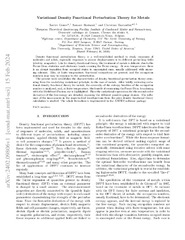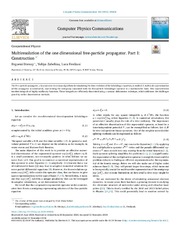Institutt for kjemi: Recent submissions
Now showing items 1-20 of 624
-
Antifouling Efficacy on S. epidermidis of Nano-Au Surfaces Functionalized with Polyethylene Glycol (PEG)-Tethered Antimicrobial Peptides
(Journal article; Tidsskriftartikkel, 2025-05-15)Cationic antimicrobial peptides (cAMPs) kill bacteria in solution by membrane lysis; however, translating cAMPs into a covalently attached antibacterial coating is challenging since it remains unclear how the specifics of the conjugation impact the antifouling efficacy. Furthermore, studies have typically assessed cAMP coatings with a high and homogeneous surface coverage, although this may be ... -
Halomonas sp. MC140, a polyhydroxyalkanoate (PHA) producer isolated from the Arctic environment
(Journal article; Tidsskriftartikkel; Peer reviewed, 2025-07-03)Polyhydroxyalkanoates (PHA) are biobased and biodegradable polyesters with potential to replace petroleum-based plastics or for use as feed in aquaculture. In this study, Halomonas sp. MC140 was isolated from the Arctic littoral environment in Norway and characterized in terms of PHA production. Phylogenetic analysis of the draft genome sequence placed the strain as closely related to Halomonas ... -
Enhanced fish performance and biosecurity by manipulation of the natural microbiome of Atlantic salmon
(Research report; Forskningsrapport, 2025)The project aimed to enhance Atlantic salmon's performance and biosecurity by manipulating their microbiome. The study investigated whether specific seawater bacteria from healthy salmon skin could improve smolts' survival after seawater transfer. Scale-explants were used to study host-bacterial interactions. Although some bacteria showed probiotic potential, they did not significantly reduce ... -
Sigmatropic rearrangement enables access to a highly stable spirocyclic nitroxide for protein spin labelling
(Journal article; Tidsskriftartikkel; Peer reviewed, 2025-05-27)Spin labelling enables the study of biomolecules using electron paramagnetic resonance (EPR) spectroscopy. Here, we describe the synthesis of a cysteine-reactive spin label based on a spirocyclic pyrrolidinyl nitroxide containing an iodoacetamide moiety. The spin label was shown to be highly persistent under reducing conditions while maintaining excellent EPR relaxation parameters up to a temperature ... -
Studenter med undervisningsoppgaver: opplevelser, utfordringer og oppfølging
(Chapter; Bokkapittel, 2024-11-21)Learning assistants are assigned a diverse set of tasks in the Norwegian higher educational system, particularly in facilitating student-centered teaching in the natural sciences. The present work is an investigation into the experiences of learning assistants in science at a Norwegian university through a thematic analysis of ten interviews with undergraduate and graduate learning assistants. The ... -
Transition metal azahemiporphycenes as singlet oxygen sensitizers
(Journal article; Tidsskriftartikkel; Peer reviewed, 2024)Using free-base tris( p -X-phenyl)corrole (X = H, Me, OMe) as starting materials and 4-aminotriazole as the nitrogen source, we used a DDQ-mediated, room-temperature strategy for generating isocorroles to obtain the corresponding 6-azahemiporphycenes, H2[X-AHP], one of which was structurally characterized with single-crystal X-ray diffraction analysis. The free-base ligands were readily derivatized ... -
Variational density functional perturbation theory for metals
(Journal article; Tidsskriftartikkel; Peer reviewed, 2024-01-30)Density functional perturbation theory (DFPT) is a well-established method to study responses of molecules and solids, especially responses to atomic displacements or to different perturbing fields (electric, magnetic). Like for density functional theory (DFT), the treatment of metals is delicate, due to the Fermi-Dirac (FD) statistics and electronic bands crossing the Fermi energy. At zero temperature, ... -
Photonics of Hydrothermally Treated β-Lactoglobulin Amyloids
(Journal article; Tidsskriftartikkel; Peer reviewed, 2024-04-24)Increased temperature and high pressure are applied to β-lactoglobulin fibrils in the autoclave, resulting in the acquisition of a composite material comprised of partially disassembled amyloid fibrils and carbon dots. Confirmation of the preservation of the β-sheet motif attributed to amyloids in the hydrothermally treated fibrils is obtained through wide-angle X-ray scattering and ThT assay. Z-scan ... -
Gas-phase thorium molecules from laser ablation
(Journal article; Tidsskriftartikkel; Peer reviewed, 2024-12-26)Laser ablation is performed on an oxidized, roughly 35-year-old <sup>232</sup>Th foil. The produced anionic and cationic molecules are investigated utilizing precision mass measurements by a multireflection time-of-flight mass spectrometer. Molecules with up to three thorium atoms are identified. This includes oxides Th<sub>n</sub>O+ x containing up to 2n −1oxygenatomsandfurtherspeciesincorporating ... -
Advancing <sup>19</sup>F NMR Prediction of Metal-Fluoride Complexes in Solution: Insights from Ab Initio Molecular Dynamics
(Journal article; Tidsskriftartikkel; Peer reviewed, 2024-12-03)<sup>19</sup>F NMR parameters are versatile probes for studying metal-fluoride complexes. Quantum chemical calculations of <sup>19</sup>F NMR chemical shifts enhance the accuracy and validity of the resonance signal assignments in complex spectra. However, the treatment of solvation effects in these calculations remains challenging. In this study, we establish a successful computational protocol ... -
Rhenium-Sulfido and -Dithiolato Corroles: Reflections on Chalcophilicity
(Journal article; Tidsskriftartikkel; Peer reviewed, 2024-12-16)he high-temperature (∼180 °C) reaction between free-base mesotriarylcorroles and Re<sub>2</sub>(CO)<sub>10</sub>, followed by exposure to PCl3 and thiols (or elemental sulfur), affords rhenium-sulfido (ReS) corroles in 67−76% yields. The use of shorter reaction times, lower temperatures (∼130 °C), and a dithiol (e.g., ethane-1,2-dithiol) also allows the isolation of rhenium-dithiolato corroles, ... -
The Microbiota of the Outer Gut Mucus Layer of the Migrating Northeast Arctic Cod (Gadus morhua) as Determined by Shotgun DNA Sequencing
(Journal article; Tidsskriftartikkel; Peer reviewed, 2024-10-31)Animals form functional units with their microbial communities, termed metaorganisms. Despite extensive research on some model animals, microbial diversity in many species remains unexplored. Here, we describe the taxonomic profile of the microbes from the outer gut mucus layer from the Northeast Arctic cod using a shotgun DNA sequencing approach. We focused on the mucus to determine if its microbial ... -
Inherent Chirality and Stereoisomerism in Metallocorrole Sandwich Compounds
(Master thesis; Mastergradsoppgave, 2024-01-07)In this thesis, I have presented my findings on stereoisomerism in eight-coordinate metallobiscorrole sandwich compounds. Metallobiscorroles were first synthesized in our laboratory about eight years ago and, although they were fully structurally characterized with X-ray crystallography, their crowded 1H NMR spectra essentially defied assignment. My master’s thesis project began with the task to ... -
2-Pyridinyl/quinolyl-phenylamino-quinoline Complexes With CF3 and C2F5 Ligated Ni
(Journal article; Tidsskriftartikkel; Peer reviewed, 2024-06-21)A new ligand architecture based on quinoline/pyridine attached ortho to the amine functionality on an aniline, which is coupled to another quinoline unit has been prepared. Ligands <b>L1</b> and <b>L2</b> have been complexed with CF<sub>3</sub> and C<sub>2</sub>F<sub>5</sub> ligated nickel centers. The resulting complexes have been extensively studied by NMR spectroscopy (on <sup>1</sup>H, ... -
Multiresolution of the one dimensional free-particle propagator. Part 1: Construction
(Journal article; Tidsskriftartikkel; Peer reviewed, 2024-11-19)The free-particle propagator, a key operator in various algorithms for simulating the time evolution of the Schrödinger equation, is studied. A multiscale approximation of this propagator is constructed, representing the semigroup associated with the free-particle Schrödinger operator in a multiwavelet basis. This representation involves integrals of highly oscillatory functions. These integrals are ... -
Multiresolution of the one dimensional free-particle propagator. Part 1: Construction
(Journal article; Tidsskriftartikkel; Peer reviewed, 2024-11-19)The free-particle propagator, a key operator in various algorithms for simulating the time evolution of the Schrödinger equation, is studied. A multiscale approximation of this propagator is constructed, representing the semigroup associated with the free-particle Schrödinger operator in a multiwavelet basis. This representation involves integrals of highly oscillatory functions. These integrals are ... -
Weekly Cumulative Quizzes in Organic Chemistry
(Journal article; Tidsskriftartikkel; Peer reviewed, 2024-11-11)A challenge in organic chemistry as well as in other subjects is that a set of fundamental skills is required to master more advanced topics. In an attempt to force students to invest in learning fundamental concepts before working with more advanced topics, we have introduced weekly compulsory quizzes and associated practice tests in our introductory organic chemistry course. The weekly quizzes are ... -
Directional Multiobjective Optimization of Metal Complexes at the Billion-Scale with the tmQMg-L Dataset and PL-MOGA Algorithm
(Journal article; Tidsskriftartikkel, 2023-09-25)Transition metal complexes (TMCs) play a key role in several areas of high interest, including medicinal chemistry, renewable energies, and nanoporous materials. The development of TMCs enabling these technologies remains challenged by the need to optimize multiple properties within very large chemical spaces, in which the thirty transition metals can be combined with a virtually infinite number of ... -
Automatisk rettet eksamen i generell kjemi
(Journal article; Tidsskriftartikkel; Peer reviewed, 2024-10-29)En god avsluttende eksamen vurderer i hvilken grad intendert læringsutbytte har blitt oppnådd på en objektiv, reproduserbar og helst autentisk måte. Det er imidlertid lite tilfredsstillende hvis en faglærer bruker mye tid på vurdering av læring framfor vurdering for læring underveis i semesteret. Derfor kan det være attraktivt å utforske muligheter med en digital automatisk rettet eksamen, spesielt ... -
Hyperspectral imaging and deep learning for parasite detection in white fish under industrial conditions
(Journal article; Tidsskriftartikkel; Peer reviewed, 2024-11-09)Parasites in fish muscle present a significant problem for the seafood industry in terms of both quality and health and safety, but the low contrast between parasites and fish tissue makes them exceedingly difficult to detect. The traditional method to identify nematodes requires removing fillets from the production line for manual inspection on candling tables. This technique is slow, labor intensive ...


 English
English norsk
norsk


















